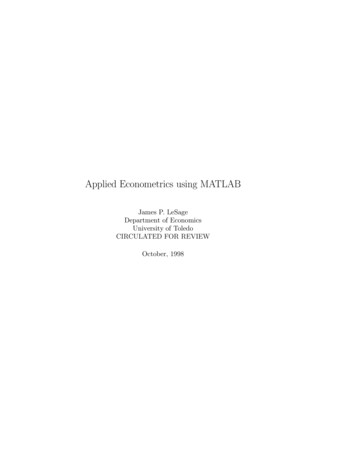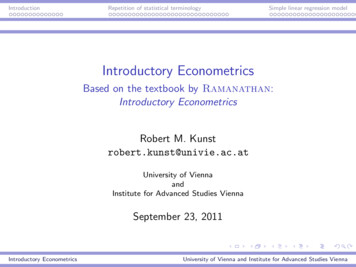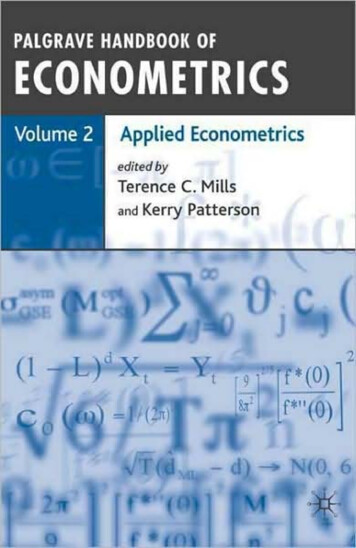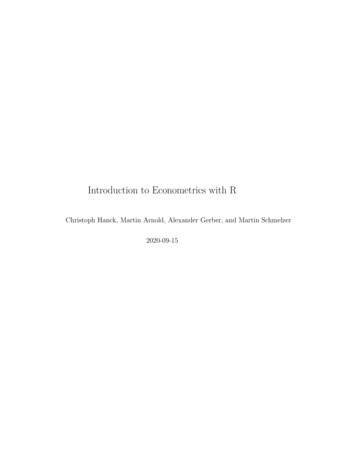
Transcription
ISSN 1440-771XAustraliaDepartment of Econometricsand Business s/pubs/wpapers/Stochastic population forecasts using functional data models formortality, fertility and migrationRob J Hyndman and Heather BoothMay 2006Working Paper 14/06
Stochastic population forecasts usingfunctional data models for mortality,fertility and migrationRob J HyndmanDepartment of Econometrics and Business Statistics,Monash University,VIC 3800, Australia.Email: Rob.Hyndman@buseco.monash.edu.auHeather BoothDemography & Sociology Program,Research School of Social Sciences,The Australian National University,Canberra ACT 0200, Australia.Email: Heather.Booth@anu.edu.au.25 May 2006JEL classification: J11, C53, C14, C32
Stochastic population forecasts usingfunctional data models for mortality,fertility and migrationAbstract: Age-sex-specific population forecasts are derived through stochastic population renewal using forecasts of mortality, fertility and net migration. Functional data models withtime series coefficients are used to model age-specific mortality and fertility rates. As detailed migration data are lacking, net migration by age and sex is estimated as the differencebetween historic annual population data and successive populations one year ahead derivedfrom a projection using fertility and mortality data. This estimate, which includes error, is alsomodeled using a functional data model. The three models involve different strengths of thegeneral Box-Cox transformation chosen to minimise out-of-sample forecast error. Uncertaintyis estimated from the model, with an adjustment to ensure the one-step-forecast variancesare equal to those obtained with historical data. The three models are then used in the MonteCarlo simulation of future fertility, mortality and net migration, which are combined using thecohort-component method to obtain age-specific forecasts of the population by sex. The distribution of forecasts provides probabilistic prediction intervals. The method is demonstratedby making 20-year forecasts using Australian data for the period 1921–2003.Key words: Fertility forecasting, functional data, mortality forecasting, net migration, nonparametric smoothing, population forecasting, principal components, simulation.1
Stochastic population forecasts using functional data models for mortality, fertility and migration1 IntroductionStochastic methods of population forecasting are rapidly gaining recognition. Stochastic population forecasts have been produced for the US, Australia and several European and othercountries, as well as for the world and world regions. In the Netherlands, official statisticalagencies now use stochastic methods, and other countries, such as the US, are also adoptingtheir use in official forecasts.Forecasts of the size and structure of the population are central to social and economic planning, from the provision of services in the short term to policy development in the long term.Not least of the demographic challenges facing developed countries is the rapid ageing ofthe population. Already developed country populations are experiencing unprecedentedlylarge elderly proportions. The major driver of this ageing process is the fertility fluctuationsof the past, notably the post-war baby boom coupled with the low fertility of recent times, butdeclining mortality is also significant. One response to population ageing and the attendantshortage of labour to provide for the elderly has been an increase in immigration to ‘replace’or make up for past shortfalls in births (Nations, 2000). Immigration has thus become a majordriver of population change in many developed countries, and in some cases amounts to asmuch as 50% of the number of births; Australia and Spain are examples.Population forecasting must take proper account of all three components of demographicchange, that is mortality, fertility and migration. While mortality forecasting has receivedconsiderable attention in recent years, methods for forecasting fertility and migration are lesswell developed. As with human behaviour in general, demographic behaviour is difficult toforecast; this is particularly so for fertility and migration. A further problem for demographicforecasting is the estimation of uncertainty: estimates may vary considerably depending onthe method of estimation (Keilman, 2001).Any forecasting exercise presupposes that the data on which the forecast is based exist insuitable form. For mortality and fertility, this is generally the case: vital registration andpopulation censuses or population registers provide lengthy series of data with the necessarydetail. For migration, however, data are often lacking: where they exist at all, they tend to bein shorter series and often inadequately represent actual migration flows. A solution to thislack of data is to estimate net migration as the difference between the increment in populationHyndman & Booth: 25 May 20062
Stochastic population forecasts using functional data models for mortality, fertility and migrationsize and natural increase using the demographic growth-balance equation. For subnationalpopulation forecasting, where internal migration forecasts are required, this method is oftenthe only approach available because data are not collected.Several different approaches to demographic forecasting have been developed. The mostwidely used are those that involve some form of extrapolation, often using time series methods. Functional data methods fall under this category, but they have only recently beenadopted in demographic forecasting (Hyndman and Ullah, 2005). Functional data methodshave the advantage of providing a flexible framework that can be used for all three demographic processes.This paper applies functional data models in forecasting mortality, fertility and net international migration for use in population forecasting. These forecast components are combinedusing the cohort-component method to produce probabilistic population forecasts by age andsex. The method is illustrated using Australian data for 1921–2003. As complete and reliabledata on international migration are lacking, annual net migration for 1972–2003 is estimatedusing the growth-balance equation.1.1 Stochastic population forecastingFully probabilistic population forecasts have the major advantage of probabilistic consistencyamong all forecast variables including ratios and other derived indices (Lee and Tuljapurkar,1994). They are generated through stochastic population renewal using the cohort-componentmethod of population projection (Preston et al., 2001, pp.119–129). The forecast is achievedeither analytically using the stochastic Leslie matrix (Lee and Tuljapurkar, 1994; Sykes, 1969)add Alho// or more simply by Monte Carlo simulation to produce a distribution of possible outcomes. In both approaches, it is necessary to specify the mean (or median), variancecovariance structure and distributional form for each demographic component. These parameters may be estimated using informed judgment and ex-post evaluation of errors (Keilman,1997; Lutz et al., 1996) or by formal statistical models (e.g., Lee, 1992)(Alho // check bothrefs//) and check Renshaw and Haberman on uncertainty.In this paper, the Monte Carlo simulation approach is adopted, and the parameters of thecomponent forecasts are derived using functional data models and time series methods. TheHyndman & Booth: 25 May 20063
Stochastic population forecasts using functional data models for mortality, fertility and migrationuse of extrapolative methods presupposes that the trends of the past will be continued into thefuture. This assumption has proved to be a better basis for forecasting than either structuralmodelling involving exogenous variables or methods based on expectation (Booth, 2006). Thefollowing brief review of forecasting the three components focuses on extrapolative methods;for a more comprehensive review, see Booth (2006).1.2 MortalityOne of the simplest methods for extrapolating mortality, commonly used by actuaries, appliesempirical age-specific geometric mortality reduction factors to current death rates to forecastfuture rates (Pollard, 1987). A more parsimonious approach is to forecast the parameters ofa ‘law’ of mortality representing the age pattern, also ensuring regularity. Among the numerous existing models, the eight-parameter Heligman-Pollard (1980) model and the multiexponential model have been used in forecasting with limited success (McNown and Rogers,1989; McNown et al., 1995; Forfar and Smith, 1987). Interdependencies among parameters callfor multivariate ARIMA models.The most prominent method in mortality forecasting is the Lee-Carter method (Lee and Carter,1992) which uses singular value decomposition to reduce annual age-specific log death ratesto a time-dependent index of the level of mortality and a set of time-independent parameters that modify the overall level at particular ages. Standard time series methods are usedto model and forecast the level index over time. The Lee-Carter method has the advantagesof parsimony and simplicity in application. These stem from the fact that the overall downward trend in mortality accounts for almost all of the variation, so that only the first term(time parameter) is forecast. Further, in most applications, a random walk with drift has beenappropriate, indicating constant rates of decline in age-specific death rates (e.g., Tuljapurkaret al., 2000).Several variants and extensions of the original Lee-Carter method have been developed. Leeand Miller’s (2001) variant is now widely used. A variant by Booth et al. (2002) has beenshown to be at least as accurate as Lee-Miller in the short term (Booth et al., 2005). TheLee-Carter method has been further developed to incorporate a heteroscedastic Poisson errorstructure (e.g., Wilmoth, 1993; Brouhns et al., 2002) and to be applicable to mortality reductionHyndman & Booth: 25 May 20064
Stochastic population forecasts using functional data models for mortality, fertility and migrationfactors (Renshaw and Haberman, 2003a). Booth et al. (2002); Renshaw and Haberman (2003c)examine the use of more than one term. Parallel approaches within the GLM framework havealso been developed (Renshaw and Haberman, 2003b).Two recent extensions of the Lee-Carter method involve incorporating nonparametric smoothing into the model. de Jong and Tickle (2006) combine spline smoothing and estimation viathe Kalman filter to fit a generalized version of the Lee-Carter model. Hyndman and Ullah(2005), following the functional data paradigm, propose smoothing the mortality curves foreach year using constrained regression splines prior to fitting a model using principal components decomposition. We extend the Hyndman-Ullah approach in this paper, and apply it tomortality, fertility and migration.1.3 FertilityUnlike mortality, childbearing is both an avoidable and repeatable event; fertility rates canthus be separated into level (quantum) and pattern (tempo) effects. These can be forecastindependently if quantum and tempo are not highly correlated, which is generally the casefor developed countries (e.g., Thompson et al., 1989). Fertility has proved difficult to forecastdue to structural change, and estimates of uncertainty are highly dependent on the particularmodel.Early forecasts of fertility used time series methods to forecast the total number of births,reflecting the role of births in population growth (Saboia, 1977; McDonald, 1979, 1981). Totalfertility and independent age-specific rates have also been forecast by time series methods(Lee, 1974; McDonald, 1984; Miller, 1986). Ortega and Poncela (2005) extend this approach toexploit common trends by jointly modelling the total fertility rates for a homogeneous clusterof countries using a dynamic factor model with common and country-specific factors.Parameterisation has been employed in the form of the gamma, beta and Hadwiger distributions (e.g., Hoem et al., 1981; Thompson et al., 1989; Congdon, 1993; Chandola et al., 1999;Keilman and Pham, 2000), and the multi-exponential model (Knudsen et al., 1993; McNownet al., 1995). Parameter interpretability and over-parameterisation can present difficulties forforecasting and multivariate time series methods are desirable.Hyndman & Booth: 25 May 20065
Stochastic population forecasts using functional data models for mortality, fertility and migrationLee (1993) forecast fertility using a parallel method to the Lee-Carter method, but found it necessary to pre-specify the long-term mean value of total fertility because of structural changeand to impose limits of 0 and 4 to reduce the width of the prediction interval (see also Lee,1999). A principal components approach was also employed by Bozik and Bell (1987) in forecasting fertility using the first four components and multivariate ARIMA methods. Hyndmanand Ullah (2005) applied a similar method in adopting a functional data approach, and thismethod is further developed on this paper.1.4 MigrationMethods for forecasting migration are the least developed among the three components andare often extremely simple (George and Perreault, 1992). One reason for this stems from a lackof suitable data. Ideally migration is separated into its two distinct processes, immigration andemigration, each of which is independently forecast by age and sex (Rogers, 1990). Decomposition by reason for migration and disaggregation of immigration by citizenship are also ideal(Hilderink et al., 2002). Forecasting immigration presents particular problems because of theuncertainty inherent in any process that is determined more by political and socio-economicconsiderations than any other.A problem with the use of immigration data, even if accurate in what they measure, is thatcoverage of actual in-migration may be incomplete. Undocumented migration is a substantialflow for some countries. The US, for example, receives an estimated 500,000 illegal immigrants per year, while in Spain the immigration amnesty of 2005 resulted in 700,000 registrations, equal to 2 per cent of the total population. In Australia, uncounted immigrationhas occurred through ‘category jumping’ whereby temporary migrants (not counted as immigrants in migration data) legally change status when inside the country, thereby becomingpermanent immigrants (Khoo and McDonald, 2002). Further, immigration data may be misleading if repeat migrants are counted each time they enter the country: overseas students, forexample, may be counted annually as long-term in-migrants but not counted as out-migrantswhen they return home for the vacation. These and other inaccuracies demand that data bedecomposed as far as possible into the different types of migrants and checked for reliability.Hyndman & Booth: 25 May 20066
Stochastic population forecasts using functional data models for mortality, fertility and migrationEmigration data present even greater problems, not least of which is that they are often unavailable or incomplete in coverage. When data are available, changes of emigration statusafter leaving the country reduce data accuracy. Reliance on the immigration data of maindestination countries suffers from incomplete coverage and problems arising from differentclassifications.Estimating net migration as the residual from the demographic growth-balance equation maybe seen as a partial solution to the problems of data inadequacy, because population data aregenerally more complete. The coverage of illegal migrants in population censuses increaseswith the passage of time and with the acquisition of permanent legal status through amnesties.However, difficulties can arise: even if the two processes of immigration and emigration arestable, the difference between them can be unstable and therefore difficult to model and forecast. Nevertheless, where detailed data are not available or are of poor quality, estimated netmigration may be the best solution.Migration numbers are often forecast rather than rates. The use of numbers is consistent withthe specification of annual quotas for immigrants, and total numbers are often forecast. Further, Miller and Lee (2004) note that numbers are preferable in that they take into account theco-variation in the rate of immigration (or positive net migration) and population denominator. This also applies to emigration. However, the use of numbers can be problematic ifage-specific emigration is forecast to exceed the age group’s population. Time series methodsare often used to forecast aggregate immigration and emigration (e.g., De Beer, 1997; Keilman and Pham, 2004; Wilson and Bell, 2004); De Beer (1997) also forecast net migration withconsistent results.The use of rates demands specification of the relevant population denominator. While emigration may be meaningfully related to the domestic population, this is less relevant for immigration though it is often used. This conceptual issue also applies to net migration; again thedomestic population is commonly used Miller and Lee (e.g., 2004). Miller (2003) forecast thetotal net migration rate for California, multiplied it by the total population in the precedingyear to obtain total net migration and then applied the most recent empirical age-sex distribution as a constant distribution for the duration of the forecast. A similar approach is usedby Miller and Lee (2004).Hyndman & Booth: 25 May 20067
Stochastic population forecasts using functional data models for mortality, fertility and migrationWhere detailed data by age are lacking, a model may be used; this also reduces the numberof parameters to be forecast. The Rogers-Castro model (Rogers and Castro, 1981; Rogers andLittle, 1994) with up to 13 parameters is the most widely used, but has been used with onlylimited success for forecasting (Rogers et al., 2005; George, 1994). Keilman and Pham (2004)used a six-parameter version of this model to disaggregate forecast totals by age.1.5 Structure of the paperIn the following section, we discuss the data requirements of our approach, and explain howderived data are obtained. Section 3 describes the functional data models we fit to each of thecomponents (mortality, fertility and net migration). In Section 4, we discuss how to simulatefuture sample paths for each of these components, thereby obtaining simulated projectionsof age-specific population numbers by sex. We apply the methodology to Australian data inSection 5 to obtain twenty-year probabilistic forecasts of the population by age and sex. Someconclusions and discussion on extensions to this approach are contained in Section 6.2 Data requirementsWe assume that age-specific birth and death numbers are available for each calendar year,and that the age-specific population numbers are available at 30 June in each year. These dataare available for most of the last century for most developed countries. We use the followingnotation for these data:Bt (x) Births in calendar year t to females of age x;DtF (x) Deaths in calendar year t to females of age x;DtM (x) Deaths in calendar year t of males of age x;PtF (x) Female population of age x at 30 June, year t;PtM (x) Male population of age x at 30 June, year t.Let ft (x) 1000Bt (x)/Pt (x) be the fertility rate (per thousand women) for females of age xMMFFFin calendar year t, and let mMt (x) Dt (x)/Pt (x) and mt (x) Dt (x)/Pt (x) be the age-specific central death rates for males and females respectively in calendar year t. Then weHyndman & Booth: 25 May 20068
Stochastic population forecasts using functional data models for mortality, fertility and migrationaverage these death rates across consecutive years to obtain mid-year to mid-year estimatesdenoted by F FFmt 1 (x) 0.5 mt 1 (x) mt (x) M MMmt 1 (x) 0.5 mt 1 (x) mt (x)The “right-arrow” notation is used to denote a shift forward in time by half a year. Thus Mmt 1 (x) is an estimate of the male death rate for age x in the year from 1 July t 1 to 30 Junet, whereas mMt 1 (x) is the observed male death rate for age x in calendar year t 1. Estimated births on a mid-year to mid-year basis are given by B t 1 (x) 0.5 [Bt (x) Bt 1 (x)].Deaths are estimated from survivorship ratios obtained from successive life tables (see Prestonet al., 2001) based on mid-year to mid-year death rates.Then, using these “mid-year” estimates, we compute the difference between the annual population and successive populations one year ahead derived from a projection using fertilityand mortality. FFGt (B) Pt 1 (0) 11 ρX FB t (j) Dt (B)j FGt (x)F Pt 1(x 1) PtF (x) MMGt (B) Pt 1 (0) ρ1 ρ Fx 0, 1, 2, . . . ; Dt (x)X MB t (j) Dt (B)j MGt (x)M Pt 1(x 1) PtM (x) Mx 0, 1, 2, . . . . Dt (x) Fwhere ρ denotes the male:female birth ratio. Thus, Gt (x) denotes the net migration (plus Ferror) for females of age x to x 1 in the year from 1 July t to 30 June t 1. Dt (B) denotes Fdeaths to females born in the interval t to t 1 and Gt (B) denotes female migrants who wereaged 0 at 30 June of year t 1.3 Functional data modelling approachTo obtain forecasts of each component, we first develop functional time series models for the F Mfive sex-specific components: mFt (x), mMt (x), ft (x), Gt (x), and Gt (x). The five models willHyndman & Booth: 25 May 20069
Stochastic population forecasts using functional data models for mortality, fertility and migrationthen be used to simulate future populations. We follow the approach of Hyndman and Ullah(2005) to model each of these components.3.1 Functional data modelsLet yt (x) denote the quantity being modelled—either mortality rates, fertility rates, or netmigration numbers for age x in year t. First we use a Box and Cox (1964) transformation ofyt (x) to allow for variation that increases with the value of yt (x). Thusyt (x) 1λ [yt (x)]λ 1if 0 λ 1; log (y (x))e tif λ 0.The value of λ determines the strength of the transformation. Then we assume the followingmodel for the transformed quantity yt (x):yt (x) st (x) σt (x)εt,xst (x) µ(x) KXβt,k φk (x) et (x)k 1where st (x) is underlying smooth function of x, εt,x IID(0, 1) and σt (x) allows the varianceto change with age and time. That is, st (x) is a smooth function of age which we observe witherror. The second equation describes the dynamics of st (x) evolving through time. In thisequation, µ(x) is the mean of st (x) across years, {φk (x)} is a set of orthogonal basis functionscalculated using a principal components decomposition, and et (x) is the model error whichis assumed to be serially uncorrelated. The dynamics of the process are controlled by thetime series coefficients {βt,k } which are assumed to behave independently of each other (thisfollows from using principal components decomposition).This model was first proposed by Hyndman and Ullah (2005) for mortality and fertility ratesalthough they used log transformations instead of the more general Box-Cox transformation.It has also been used by Erbas et al. (2006) for forecasting breast cancer mortality rates.As Hyndman and Ullah (2005) point out, the model is a generalization of the well-known LeeCarter (1992) model for forecasting mortality rates. In the Lee-Carter approach, yt (x) denotesmortality rates and λ 0 so that yt (x) represents log mortality for year t and age x. TheHyndman & Booth: 25 May 200610
Stochastic population forecasts using functional data models for mortality, fertility and migrationLee-Carter method does not assume smoothness, so σt (x) 0 and yt (x) st (x). Then µ(x) isestimated as the average of yt (x) across years, K 1, and φ1 (x) and βt,1 are computed fromthe first principal component of the matrix of [yt (x) µ̂(x)]. Forecasts are obtained by fittinga time series model to βt,1 ; in practice this is almost always a random walk with drift.In this paper, we extend the methodology of Hyndman and Ullah (2005) by using a moregeneral transformation, and by applying the model to net migration as well as mortality andfertility rates. We also modify the method Hyndman and Ullah used for calculating forecasting variance to allow for better calibration with the observed data.Hyndman and Ullah proposed robust estimation of the model terms in order to handle theeffect of epidemics and wars on mortality data. We will avoid this additional complexity inmodelling Australian data by restricting mortality data to 1950 onwards.The modelling steps (described in detail in Hyndman and Ullah, 2005) are:1 Estimate smooth functions st (x) using nonparametric regression applied to yt (x) foreach year t. (In our application to Australian data, we use weighted penalized regressionsplines.)2 Estimate µ(x) as the mean of st (x) across years.3 Estimate βt,k and φk (x), k 1, . . . , K, using principal components decomposition of[yt (x) µ̂(x)].4 Estimate time series models for βt,k , k 1, . . . , K. We use exponential smoothing statespace models.The value of K must be specified. Hyndman and Ullah (2005) proposed selecting K to minimize the mean integrated squared forecast error. Since then, we have found that the methodology is insensitive to the choice of K provided K is large enough. That is, there is little cost(apart from computing time) in choosing a large K, whereas a K too small may result in poorforecast accuracy. Consequently, in this analysis we choose K 6 for all components; thisseems to be larger than any of the components really require.The observational variance, σt2 (x), depends on the nature of the data. For mortality data,Hyndman & Booth: 25 May 200611
Stochastic population forecasts using functional data models for mortality, fertility and migrationwhere yt (x) mt (x), we assume deaths have a binomial distribution so that yt (x) has approximate variance Pt 1 (x)yt (x)[1 yt (x)]. Thus, the variance of yt (x) is (via a Taylor approximation)σt2 (x) [1 yt (x)][yt (x)]2λ 1 Pt 1 (x).(1)For fertility data, where yt (x) ft (x), we assume that births have a Poisson distribution sothat yt (x) has approximate variance Pt 1 (x)yt (x)/1000. Thus, the variance of yt (x) is (via thesame Taylor approximation)σt2 (x) [yt (x)/1000]2λ 1 Pt 1 (x).(2)For migration data, there is no reasonable distributional assumption. So we estimate σt2 (x) bya nonparametric regression of [yt (x) st (x)]2 against x.The success of the model depends on how well the bivariate surface {st (x) µ(x)} can beapproximated by the sum of a few products of univariate functions of time (t) and age (x).So far, we have applied this model to mortality data from about twenty different countries,and to fertility data and migration data from Australia. This experience suggests that themodel is good at producing point forecasts, but not very good at estimating forecast variance.Consequently, we propose below an adjustment to the forecast variance implied by the model.3.2 Functional forecastsSuppose we have data up to time t n, and we wish to estimate future values of yt (x) fort n 1, . . . , n h and all x. Let β̂n,k,h denote the h-step ahead forecast of βn h,k , let ŷn,h (x)denote the h-step ahead forecast of yn h (x) and let ŝn,h (x) denote the h-step ahead forecast ofsn h (x). Thenŷn,h (x) ŝn,h (x) µ̂(x) KXβ̂n,k,h φ̂k (x) .(3)k 1A forecast of yt (x) is found through back-transformation.Following Hyndman and Ullah (2005), we can give the following expression for forecast varianceVh (x) Var[sn h (x) I, Φ] σ̂µ2 (x) KXun h,k φ̂2k (x) v(x)(4)k 1Hyndman & Booth: 25 May 200612
Stochastic population forecasts using functional data models for mortality, fertility and migrationwhere I {yt (xi )} denotes all observed data, un h,k Var(βn h,k β1,k , . . . , βn,k ) can beobtained from the time series model, σ̂µ2 (x) (the variance of the smooth estimate µ̂(x)) can beobtained from the smoothing method used, and v(x) is estimated by averaging ê2t (x) for eachx. Thus, the smoothing error is given by the first term, the error due to predicting the dynamics is given by the second term, and the third term gives the error due to the unexplaineddynamic variation. After the observational error is also included, we obtainVar[yn h (x) I, Φ] Vh (x) σt2 (x).Note that correlations between ages are naturally dealt with in this formulation due to thesmooth functions of age (x). Also, correlations between years are handled by the time seriesmodels for the coefficients βt,1 , . . . , βt, K.For low values of h, we can check the validity of Vh (x) by computingWh (x) n hX1[st h (x) ŝt,h ]2n h m 1 t mwhere m is the smallest number of observations used to fit a model. In practice, considerabledifferences between Wh (x) and Vh (x) can occur. Consequently, we use the following adjustedvariance expression:Var[yn h (x) I, Φ] Vh (x)W1 (x)/V1 (x) σt2 (x).(5)This adjusts the variance so that the one-step forecast variance matches the observed insample one-step forecast variance. It is assumed that the same multiplicative adjustment isapplicable at higher forecast horizons.Note that we can similarly check the bias of the point forecasts by averaging st h (x) ŝt,h ,but empirical results suggest the model provides excellent forecasts.4 Stochastic cohort simulation from functional data models F MFor each of mFt (x), mMt (x), ft (x), Gt (x), and Gt (x), we simulate a large number of futuresample paths which are then used to compute future sample paths of the age-sex-specificHyndman & Booth: 25 May 200613
Stochastic population forecasts using functional data models for mortality, fertility and migrationpopulation. For each component, we use the time series models to generate random samplepaths of βt,k for t n 1, . . . , n h conditional on β1,k , . . . , βn,k . We also generate randomvalues of et (x) by bootstrapping the estimated values.Having obtained the simulated va
Department of Econometrics and Business Statistics, Monash University, VIC 3800, Australia. Email: Rob.Hyndman@buseco.monash.edu.au Heather Booth Demography & Sociology Program, Research School of Social Sciences, The Australian National University, . 1994; Sykes, 1969) add Alho// or more simply by Monte Carlo simulation to produce a .










